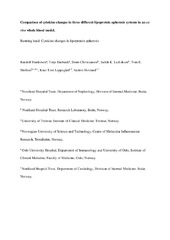Comparison of cytokine changes in three different lipoprotein apheresis systems in an ex vivo whole blood model
Permanent link
https://hdl.handle.net/10037/17432Date
2019-11-29Type
Journal articleTidsskriftartikkel
Peer reviewed
Author
Hardersen, Randolf Inge; Enebakk, Terje; Christiansen, Dorte; Ludviksen, Judith K; Mollnes, Tom Eirik; Lappegård, Knut Tore; Hovland, AndersAbstract
Methods - We evaluated how whole blood adsorption, dextran sulfate plasma adsorption, and double filtration plasmapheresis lipoprotein apheresis systems affected cytokine concentrations, using a human whole blood ex vivo model differentiating the effect of the lipoprotein apheresis and plasma separation columns and describing temporal changes.
Results - Compared to the control bag, the whole blood adsorption system reduced Interferon‐γ (IFN‐γ), IL‐8, IL‐1ra, eotaxin, tumor necrosis factor (TNF), monocyte chemoattractant protein 1 (MCP‐1), platelet derived growth factor (PDGF)‐BB, regulated on activation T cell expressed and secreted (RANTES), macrophage inflammatory protein‐1β (MIP‐1β), and IP‐10 (P < .05). The dextran sulfate plasma adsorption system reduced IFN‐γ, IL‐8, IL‐1ra, eotaxin, TNF, MCP‐1, PDGF‐BB, MIP‐1β, and IP‐10 (P < .05). Vascular endothelial growth factor (VEGF) and granulocyte macrophage colony stimulating factor (GM‐CSF) were increased in the whole blood and dextran sulfate plasma adsorption systems (P < .05). The double filtration plasmapheresis system reduced IFN‐γ, IL‐1ra, TNF, MIP‐1β, and IP‐10 (P < .05), while MCP‐1,VEGF, GM‐CSF, and RANTES were increased (P < .05). The plasma separation column increased concentration of RANTES, and was a barrier to reduction of eotaxin. Temporal patterns of concentration change indicated first pass increase of PDGF‐BB and first pass reduction of IP‐10.
Conclusion - There were marked differences in how the three systems affected total and temporal cytokine concentration changes in this in vitro model, as well as compared to former in vivo studies.


 English
English norsk
norsk